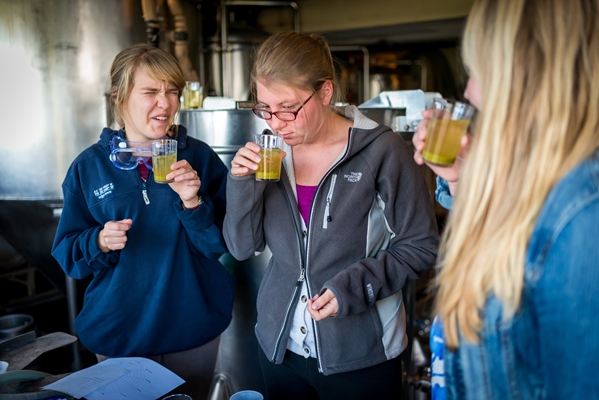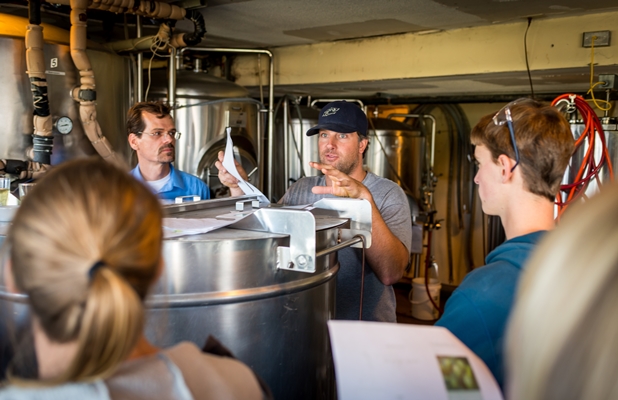The Science, and Art, of Brewing
by Ruth Graham
It's just before 4 p.m. on Tuesday, and Colby-Sawyer students are bustling into the Flying Goose Brew Pub and Grille, a popular bar and restaurant just down the hill from campus. But these students aren't knocking off early from their studies for a beer. They're heading to class.
Welcome to Brewing Science, a two-credit course that made its debut at Colby-Sawyer this fall. Also known as Science 250, the class is taught by Darrell Kuykendall, a chemistry professor who joined the Colby-Sawyer faculty in 2013. Rik Marley, the “braumeister” at the Flying Goose, is the expert who makes the classroom lessons come to bubbly life. As the syllabus puts it, the class “is designed to introduce students to the principles and practices of the brewing of craft beer.” That means Monday afternoons in the classroom and Tuesdays getting hands-on experience in the “laboratory” — the brewery beneath the dining room at the Flying Goose.
On this particular Tuesday, the lesson at the lab is on analyzing hops, the flowers that give beer its flavor. Marley and Professor Kuykendall pass out small cups of dry, pellet-like hops, and cups of water in which other pellets have been dissolved. Then, students are tasked with generating their own detailed descriptions of the flavor profile of both the dry hops and those dissolved in water. They are both a variety called American Columbus, which Marley says is one of his favorites to use in his own brewing. Kuykendall hands out blank “spider charts” for students to map their impressions. “Remember, this is all qualitative,” he says. Brewing is not just a science, it's an art.
Students spread out with their materials, and begin sniffing the hops and consulting a chart of 12 odor and flavor descriptors used by professional brewers: Menthol, Vegetal, Cream Caramel, and more. “I'm getting a hint of apple blossom,” one student says, marking a dot on the “Floral” axis on his chart. Students are wearing tall rain boots in a variety of colors to protect them from the liquids that often slosh around the floor of the brewery. Other safety equipment for the class includes protective goggles and thermal-protection gloves, although those aren't needed today. But wait until next week's lab: “Boiling and hop additions.”

Brewing Science filled to capacity — 15 students — in less than a minute on registration day last spring. Just a few minutes later, the waiting list was full. “I had to be up at, like, 7 a.m. to register,” says Melinda Nystrand '15, a psychology major. The class has attracted students from a wide variety of majors: biology, environmental science, even child development. The only requirement: Students had to be 21 by the time the semester began.
After sessions on malt, yeast and fermentation, the students' work will culminate in a collaborative project: Creating the recipe for a brand-new beer, and then brewing it themselves at the Flying Goose. It will likely be a pale ale, due to time constraints, but otherwise the flavor profile will be in the students' hands. The result will be a six-barrel batch — almost 200 gallons — of a brand-new beer. How many students can toast the end of the semester with a beer they crafted themselves?
The idea for the class goes back to last fall. Professor Kuykendall was chatting with a senior student doing a research project in a room next to his office, and the subject of their mutual love of craft beer came up. “We should have a brew pub here,” one of them joked. But almost immediately, it became obvious the idea was promising — and possible. Professor Kuykendall shared the idea with his faculty mentor, Associate Professor of Business Administration Bill Spear, who took it to Vice President and Dean of Students David Sauerwein. After many conversations between them and with other faculty and staff, as well as an enthusiastic meeting with Flying Goose owner Tom Mills, Brewing Science was born.
Professor Kuykendall has been interested in home brewing for almost a decade. He also makes wine, and has dabbled in making cheese and yogurt at home. “I got fascinated, and still am, with the idea that this really old single-cell organism called yeast can do so much crazy stuff with food and drink,” he says. “When you think of how much food we enjoy — and that's part of our culture, and that we enjoy socially — is due to this tiny million-year-old organism, it's really awe-inspiring. I guess that's why I'm a geek.”

Luckily for Colby-Sawyer students, Professor Kuykendall's hobby also has a natural connection to his career. To a casual drinker enjoying a pint at the Flying Goose, the similarity between brewing and chemistry class might be surprising. But as it turns out, making beer requires a precise heating process to stimulate chemical reactions, attention to surface area, the stimulation of “isomerization” reactions, the transformation of glucose into ethanol and other compounds, and so on. “As an organic chemist, it's my language,” Professor Kuykendall says, calling the yeast that's essential to brewing “basically a little box of chemical machinery.”
Ostensibly, of course, Professor Kuykendall's role in class to teach the chemistry, while Marley is the hands-on guy. But Professor Kuykendall's enthusiasm for brewing and complex flavors is contagious, and Marley tosses around terms like “alpha acids” and “solubilizing the lupulin” in the classroom. A visitor to class who didn't know which teacher was which might take a few minutes to sort them out.
The broader context for the new course is the extraordinary rise in the popularity of craft brewing in the United States. What was once an obscure corner of the drinking world is now a $14 billion industry that makes up 14 percent of the American beer market. That means not just better sipping for the country's beer lovers, but more than 100,000 jobs — and growing.
One place the industry is expanding into is Colby-Sawyer's own campus. The brew pub that was dreamed of last fall is now under construction at the Lethbridge Lodge, thanks to the efforts of the administration and members of a committee that includes faculty from several departments. Professor Kuykendall has been delighted, and even a little surprised, by how speedily the plans are becoming a reality: Construction began within two days of getting the required permits. “It's been moving quickly,” he says. “A lot of things of this magnitude can take a couple of years to roll out, but we had support all the way around.”
Eventually, the idea is for brewing to take place on-site, though those plans will take longer to implement. Professor Kuykendall also hopes to develop a local beer, made exclusively with ingredients sourced within 20 miles of campus. For now, one thing is certain: On tap when the pub opens will be a selection of Rik Marley's Flying Goose brews — and the brand-new batch created by the students in Brewing Science.
Colby-Sawyer College is a comprehensive college that integrates the liberal arts and sciences with professional preparation. Founded in 1837, Colby-Sawyer is located in the scenic Lake Sunapee Region of central New Hampshire. Learn more about the college's vibrant teaching and learning community at www.colby-sawyer.edu.
Colby-Sawyer College, 541 Main Street, New London, N.H. 03257 (603) 526-3000


